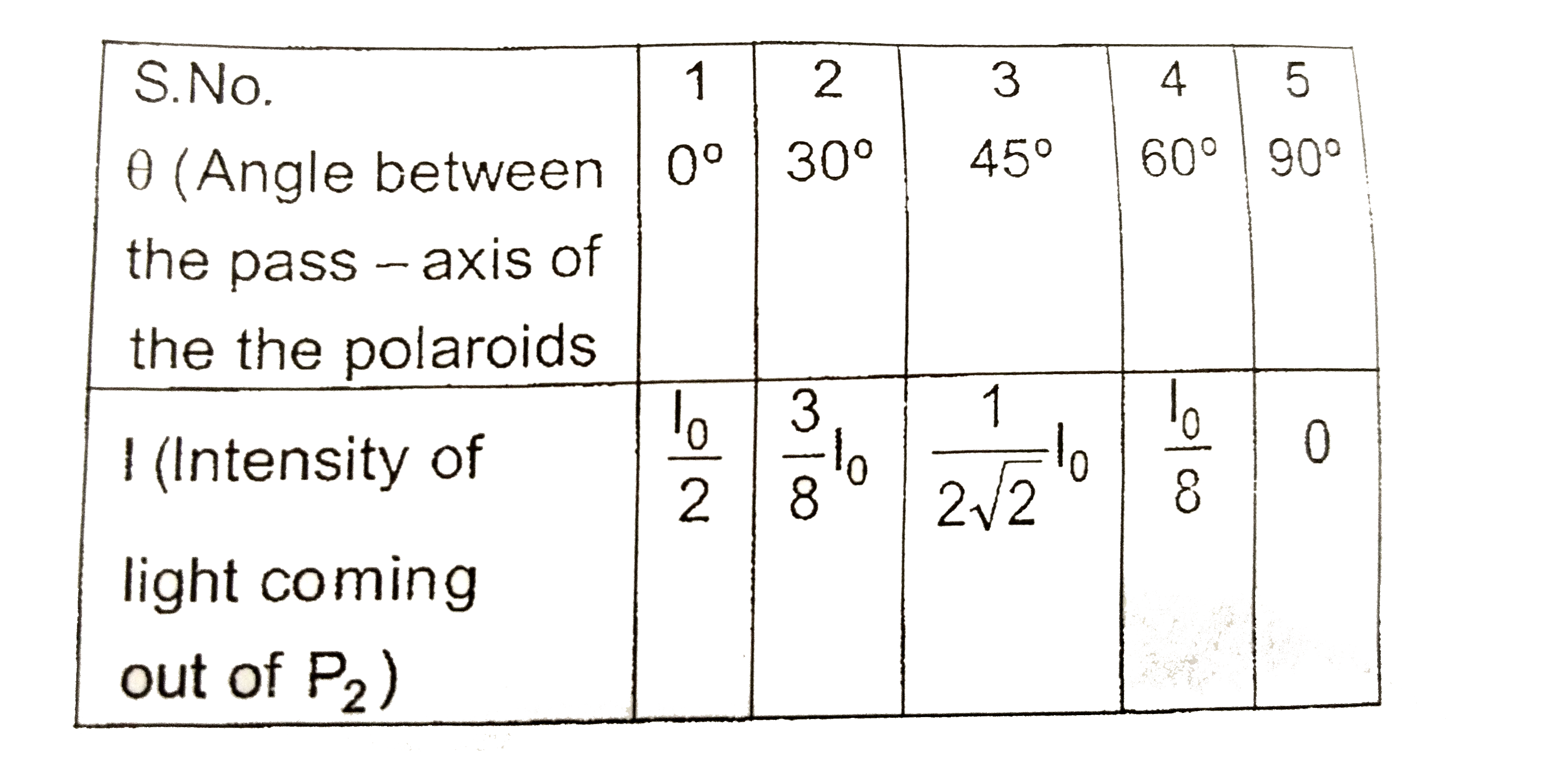Unpolarised light is passed through a polaroid P1. When this poalrised beam passes through another polaroid P2, and if the pass axis of P2 makes an angle θ with pass axis of P1, then write the expression for the polarised beam passing through P2. Draw a plot showing the variation of intensity when θ varies from 0 to 2 π.
To solve the problem, we will follow these steps:
Step 1: Understand the Situation
We have unpolarized light passing through a polaroid P1, which polarizes the light. The intensity of the unpolarized light before passing through P1 is I0.
Step 2: Determine the Intensity After P1
When unpolarized light passes through the first polaroid P1, the intensity of the polarized light that emerges from P1 is given by:
I1=I02
This is because a polaroid transmits half of the intensity of unpolarized light.
Step 3: Analyze the Second Polaroid P2
Now, this polarized light passes through another polaroid P2, which is oriented at an angle θ with respect to the pass axis of P1.
Step 4: Apply Malus's Law
According to Malus's Law, the intensity I2 of the light passing through the second polaroid P2 is given by:
I2=I1cos2(θ)
Substituting I1 from Step 2, we get:
I2=(I02)cos2(θ)
Step 5: Final Expression
Thus, the final expression for the intensity of the polarized beam passing through P2 is:
I2=I02cos2(θ)
Step 6: Plot the Variation of Intensity
To plot the variation of intensity I2 as θ varies from 0 to 2π:
- At θ=0: I2=I02
- At θ=π2: I2=0
- At θ=π: I2=I02
- At θ=3π2: I2=0
- At θ=2π: I2=I02
The graph will show a cosine squared wave, oscillating between 0 and I02 with a period of π.
We have unpolarized light passing through a polaroid P1, which polarizes the light. The intensity of the unpolarized light before passing through P1 is I0.
When unpolarized light passes through the first polaroid P1, the intensity of the polarized light that emerges from P1 is given by:
I1=I02
This is because a polaroid transmits half of the intensity of unpolarized light.
Now, this polarized light passes through another polaroid P2, which is oriented at an angle θ with respect to the pass axis of P1.
According to Malus's Law, the intensity I2 of the light passing through the second polaroid P2 is given by:
I2=I1cos2(θ)
Substituting I1 from Step 2, we get:
I2=(I02)cos2(θ)
Thus, the final expression for the intensity of the polarized beam passing through P2 is:
I2=I02cos2(θ)
To plot the variation of intensity I2 as θ varies from 0 to 2π:
- At θ=0: I2=I02
- At θ=π2: I2=0
- At θ=π: I2=I02
- At θ=3π2: I2=0
- At θ=2π: I2=I02
Topper's Solved these Questions
- BOOK - XII BOARD PREVIOUS YEAR PAPER ENGLISHCHAPTER - XII BOARDSEXERCISE - SECTION-C50videos
XII BOARDS
- BOOK - XII BOARD PREVIOUS YEAR PAPER ENGLISHCHAPTER - XII BOARDSEXERCISE - PHYSICS (Theory) DELHI BOARD -2016 [SET -I][COMPTT.]11videos
XII BOARDS
- BOOK - XII BOARD PREVIOUS YEAR PAPER ENGLISHCHAPTER - XII BOARDSEXERCISE - SECTION-A28videos
XII BOARDS
- BOOK - XII BOARD PREVIOUS YEAR PAPER ENGLISHCHAPTER - SAMPLE PAPER 2019EXERCISE - SECTION D6videos
SAMPLE PAPER 2019
Similar Questions
A plane polarised light is passed through a polaroid, when the polaroid is given one full rotation about the direction of light, then
View SolutionPlane polarised light is passed through a polaroid. On viewing through the polaroid we find that when the polaroid is given one complete rotation about the direction of light
View SolutionThe direction cosines of the line passing through P(2,3,−1) and the origin are
View SolutionA polarised light intensity I0 is passed through another polariser whose pass axis makes an angle of 60∘ with the pass axis of the former, What is the intensity of emergent polarised light from second polarised?
View SolutionHow does an unpolarised light get polarised when passed through a polaroid ?
Two polaroids are set in crossed positions . A third polaroid is placed between the two making an angle θ with the pass axis of the first polaroid . Write the expression for the intensity of light transmitted from the second polaroid . In what orientations will the transmitted intensity be (i) minimum and (ii) maximum ?View SolutionThe circle passing through the point (-1,0) and touching the y-axis at (0,2) also passes through the point:
View SolutionA beam of unpolarised light of intensity I0 is passed through a polaroid and then through another polaroid B which is oriented so that its principal plane makes an angle of 45∘ relative to that of A. The intensity of the emergent light is
View SolutionA polarized light of intensity I0 is passed through another polarizer whose pass axis makes an angle of 60∘ with the pass axis of the former, What is the intensity of emergent polarized light from second polarizer?
View SolutionThe circle passing through (1, -2) and touching the axis of x at (3, 0) also passes through the point
View Solution(a) Light, from a sodium lamp, is passed through two polaroid sheets P1 and P2 kept one after the other. Keeping P1 fixed, P2 is rotated so the its 'pass-axis' can be at different angles, θ, with respect to the pass-axis of P1
An experimentalist records the following data for the intensity of light coming out P2 as a function of the angle θ.

[I0= Intensity of beam falling on P1]
One of these observation is not is agreement with expected theoretical variation of l. ldentify this observation and write the correct expression.
(b) Define Brewster angle and write the expression for it in terms of the refractive index of the medium.View Solution

